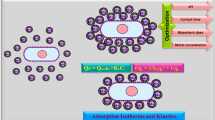Abstract
Objective
This study aims to investigate the attachment of Acidithiobacillus ferrooxidans to pyrite in two different environments: fresh and saline water (water with 35 g/L of NaCl or 0.6 M). Adsorption isotherms were analyzed using the Langmuir and Freundlich models. Saline water is water with 35 g/L of NaCl (0.6 M), which is the concentration of NaCl in seawater. The use of raw seawater in mining is becoming relevant in leaching and flotation process. At the same time the use of microorganisms in both processes is gaining attention. For this reason, it is important to study the behavior of adherence of microorganisms to minerals in saline aqueous environments, similar to seawater.
Results
The bacteria showed a higher level of attachment to pyrite in fresh water than in saline water. The Langmuir model fitted better the experimental data obtained in fresh water than in saline water with a coefficient of determination (R2) of 0.85 and 0.61 for fresh and saline water, respectively.
Conclusions
This suggests that the bacteria tend to adhere more as a monolayer in fresh than in saline water in the early stage of adhesion.






Similar content being viewed by others
References
Castro S (2012) Challenges in flotation of Cu-Mo sulfide ores in sea wáter. In: Drelich J (ed) Water in mineral processing. Society for mining, metallurgy and exploration, Englewood, pp 29–40
Chandraprabha M, Natarajan K, Modak JM (2004) Selective separation of pyrite and chalcopyrite by biomodulation. Colloids Surf B 37:93–100
COCHILCO (2018) Proyección de consumo de agua en la minería del cobre 2018–2029; Gobierno de Chile: Santiago
Daoud J, Karamanev D (2006) Formation of jarosite during Fe2+ oxidation by Acidithiobacillus ferrooxidans. Miner Eng 19:960–967
Donati ER, Sand W (2007) Microbial processing of metal sulfides. Springer, Berlin
Flemming HC, Wingender J (2010) The biofilm matrix. Nature Rev Microbiol 8:623–633
Hosseini T, Kolahdoozan M, Tabatabaei Y, Oliazadeh M, Noaparast M, Eslami A, Manafi Z, Alfantazi A (2005) Bioflotation of Sarcheshmeh copper ore using Thiobacillus ferrooxidans bacteria. Miner Eng 18:371–374
Mehrabani J, Mousavi S, Noaparast M (2011) Evaluation of the replacement of NaCN with Acidithiobacillus ferrooxidans in the flotation of high-pyrite, low-grade lead–zinc ore. Sep Purif Technol 80:202–208
Misra M, Bukka K, Chen S (1996) The effect of growth medium of Thiobacillus ferrooxidans on pyrite flotation. Miner Eng 9:157–168
Nagaoka T, Ohmura N, Saiki H (1999) A novel mineral flotation process using Thiobacillus ferrooxidans. Appl Environ Microbiol 65:3588–3593
Ohmura N, Kitamura K, Saiki H (1993) Mechanism of microbial flotation using Thiobacillus ferrooxidans for pyrite suppression. Biotechnol Bioeng 41:671–676
Pogliani C, Donati E (2000) Immobilisation of Thiobacillus ferrooxidans: importance of jarosite precipitation. Process Biochem 35:997–1004
Rawlings DE (2005) Characteristics and adaptability of iron-and sulfur-oxidizing microorganisms used for the recovery of metals from minerals and their concentrates. Microb Cell Fact 4:13
San Martín F, Kracht W, Vargas T (2018) Biodepression of pyrite using Acidithiobacillus ferrooxidans in seawater. Miner Eng 117:127–131
Schaechter M (2009) Encyclopedia of microbiology. Academic Press, San Diego
Tan SN, Chen M (2012) Early stage adsorption behavior of Acidithiobacillus ferrooxidans on minerals I: an experimental approach. Hydrometallurgy 119:87–94
Xia L, Shen Z, Vargas T, Sun W, Ruan R, Xie Z, Qiu G (2013) Attachment of Acidithiobacillus ferrooxidans onto different solid substrates and fitting through Langmuir and Freundlich equations. Biotechnol Lett 35:2129–2136
Acknowledgements
The authors are grateful to the Biohydrometallurgy Laboratory of Department of Chemical Engineering, Biotechnology and Materials, University of Chile for allowing the use of their installations and equipment.
Funding
This study was funded by Chilean National Commission for scientific and Technological Research (Comisión Nacional de Investigación Científica y Tecnológica, CONICYT) through project number BMBF20150026.
Author information
Authors and Affiliations
Corresponding author
Ethics declarations
Conflict of interest
All authors declare that they have no conflict of interest.
Research involving human and animal rights
This article does not contain any studies with human participants or animals performed by any of the authors.
Additional information
Publisher's Note
Springer Nature remains neutral with regard to jurisdictional claims in published maps and institutional affiliations.
Rights and permissions
About this article
Cite this article
San Martín, F., Kracht, W. & Vargas, T. Attachment of Acidithiobacillus ferrooxidans to pyrite in fresh and saline water and fitting to Langmuir and Freundlich isotherms. Biotechnol Lett 42, 957–964 (2020). https://doi.org/10.1007/s10529-020-02842-z
Received:
Accepted:
Published:
Issue Date:
DOI: https://doi.org/10.1007/s10529-020-02842-z




